KENTUCKY BANKER


NOVEMBER/DECEMBER 2022 Official Publication of the
Bankers Association Ground Breaks on New Main Office page 8 FNB Bank Rebuilding in Mayfield
Kentucky
Cards Issued by First Century Bank, N A member FDIC, pursuant to a license from Visa U.S.A. Inc.”





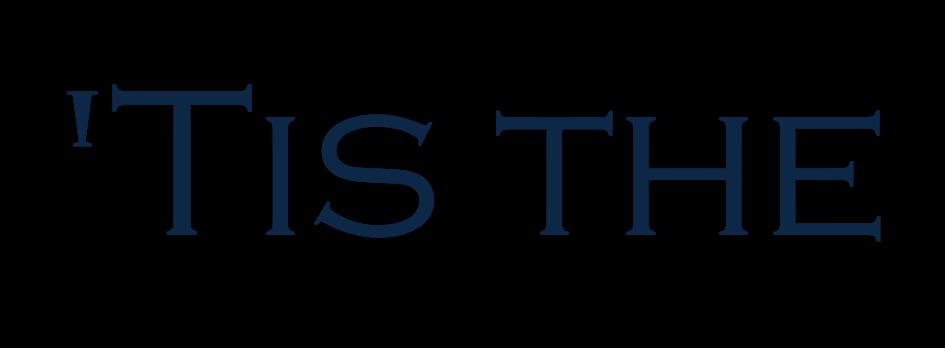





Learn
More
“We were content with the coverage we had and were not shopping our plan. After meeting with KBA Insurance Solutions, we had no choice but to make the move to Chuck and his team. They proposed a thoughtful plan design & introduced benefits that we had not previously offered. When we showed the rates KBA Insurance Solutions offered to our prior agent, she said: “…you have to make this change.” Since changing our results have been better coverage, expanded offerings and greater cost savings. I would highly recommend that any bank explore the options available through KBA Insurance Solutions.”


Mr. Charlie Dicken, EVP Trust Officer, First Kentucky Trust


Property & Casualty Collateral Protection Employee Benefits Fee Income Cyber BOLI WE
KenBanc Insurance Account Representative cell
bmaggard@kybanks.com
Maggard KenBanc Insurance President & CEO cell 606-682-1950 cmaggard@kybanks.com
Mattingly KBA Benefit Solutions Director of Sales & Service cell 502-377-4048 lmattingly@kybanks.com
KNOW BANKS Brandon Maggard
606-682-2769
Chuck
Lisa
FREE COVERAGE REVIEW Let us use our expertise to review your bank’s coverage so you can get to the business of serving your communities.
WHO WE ARE: The KBA is a nonprofit trade association that has been providing legislative, legal, compliance and educational services to its member institutions since 1891. KBA's directors and staff work together with its members to make the financial services industry a more effective and successful place to work. The strength of the KBA is bankers unifying as an industry to speak as one voice.
WHAT WE DO: The purpose of the Kentucky Bankers Association is to provide effective advocacy for the financial services industry both in Kentucky and on a national level; to serve as a reliable and responsive source of information and education about areas of interest to the industry; and to provide a catalyst and forum for collective industry action. The KBA does this in 4 ways:
1. Government relations & industry advocacy 2. Information interchange 3. Education 4. Products and services kybanks.com

KENTUCKY BANKERS ASSOCIATION

600 West Main Street, Suite 400 Louisville, Kentucky 40202
KBA STAFF
Ballard W. Cassady Jr. President & CEO bcassady@kybanks.com
Debra K. Stamper EVP & General Counsel dstamper@kybanks.com
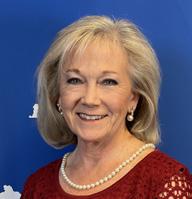
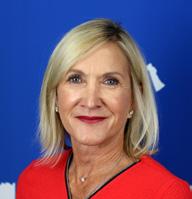
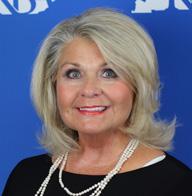
Miriam Cole Executive Assistant mcole@kybanks.com
John P. Cooper Legislative Solutions jcooper@kybanks.com
Paula Cross Education Coordinator pcross@kybanks.com
Nina K. Gottes
Sponsorship & Business Development ngottes@kybanks.com
Casey Guernsey Enrollment and Billing Specialist cguernsey@kybanks.com
Jamie Hampton Education Coordinator jhampton@kybanks.com
McKenzie Just Caldwell Staff Accountant mcaldwell@kybanks.com
Chuck Maggard President & CEO KenBanc Insurance cmaggard@kybanks.com

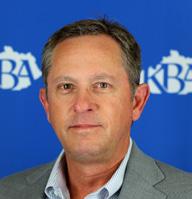

Lisa Mattingly Director of Sales & Service KBA Benefit Solutions lmattingly@kybanks.com


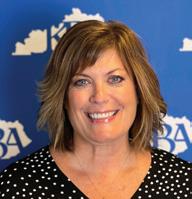
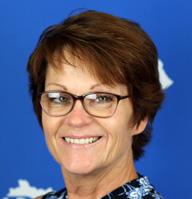

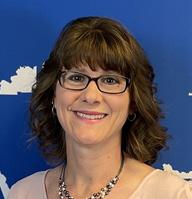
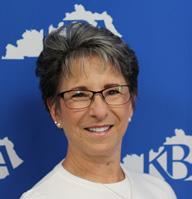

Donna McCartin Benefit Support Specialist dmccartin@kybanks.com
Tammy Nichols Finance Officer HOPE of the Midwest tnichols@kybanks.com
Katie Rajchel Accounting Manager krajchel@kybanks.com


Selina O. Parrish Director of Membership sparrish@kybanks.com
Timothy A. Schenk Deputy General Counsel Director of Education tschenk@kybanks.com

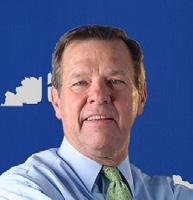
Jennifer Schlierf Sales Support KBA Insurance Solutions jschlierf@kybanks.com




Matthew E. Vance, CPA Chief Financial Officer mvance@kybanks.com
Tamuna Loladze
Chief Operating Officer HOPE of the Midwest tloladze@kybanks.com Michelle Madison IT Manager mmadison@kybanks.com
Billie Wade Executive Director HOPE of the Midwest bwade@kybanks.com
Audrey Whitaker Insurance Services Coordinator awhitaker@kybanks.com
Brandon Maggard Account Representative KenBanc Insurance bmaggard@kybanks.com
KENTUCKY BANKER is the official bi-monthly magazine of the Kentucky Bankers Association (KBA). No part of this magazine may be reproduced without express written permission from the KBA. The KBA is not responsible for opinions expressed by outside contributors published in KENTUCKY BANKER. The KBA reserves the right to publish submissions at the discretion of the KENTUCKY BANKER editorial team. For more information, or to submit an article, pictures or pass on a story lead, contact Josh Fischer, Managing Editor, 502-736-1283 or jfischer@kybanks.com facebook.com/kybankers Bold frame denotes management team member. Please feel free to email us, we are here to help!

GROUP REPRESENTATIVES
Represents Group 1
Jeff McDaniels, President & CEO
Farmers Bank & Trust Company

Represents Group 2
Michael W. Hunt, President & CEO
The Sacramento Deposit Bank
Represents Group 3
Greg Pawley, President & CEO
The Cecilian Bank
Represents Group 4
Jason T. Jones, President
Morgantown Bank & Trust Co.
Represents Group 5
Don D. Jennings, CEO
First Federal Savings Bank of KY
Represents Group 6 Charles Beach, III, Chairman Peoples Exchange Bank

Represents Group 7
D. Alex Cook, President & CEO
Hearthside Bank
Represents Group 8
Anthony Kinder, President & CEO
Peoples Bank of Kentucky

Represents Group 9 James Ayers, Regional Manager
First State Bank, Inez
THRIFT REPRESENTATIVE
Jaime Coffey, President & CEO

First Federal Savings & Loan of Hazard
BANK SIZE REPRESENTATIVES
Represents
Michael F. Beckwith, Chief Commercial Banking Officer, German American Bank
Represents Banks w/ Assets of -$1B & at least $200M
H. Alexander Downing, President & CEO Franklin Bank & Trust Company
EDUCATION ALLIANCE REPRESENTATIVE
Lanie W. Gardner, Community President
First Southern National, Central City
W. Fred Brashear, II, President & CEO Hyden Citizens Bank
Banks w/ Assets of $1B+
BENEFITS TRUST
KBA
COMMITTEE REPRESENTATIVE
2022-2023 OFFICERS & BOARD Want to advertise in KENTUCKY BANKER magazine? CONTACT Nina Gottes Sponsorship & Business Development
513-293-2467 ADVERTISE IN KENTUCKY BANKER WANT TO BECOME A KBA SPONSOR? Visit: kbasponsorship.com ON THE COVER Heigold House Façade / Louisville, KY CHAIRWOMAN Ruth O’Bryan Bale, Chairwoman South Central Bank VICE CHAIRMAN Mark D. Strother, President & CEO The Commercial Bank of Grayson TREASURER April R. Perry, Chairwoman & CEO Kentucky Farmers Bank Corporation PAST CHAIRMAN James A. Hillebrand, Chairman & CEO Stock Yards Bank & Trust Co. KBA PRESIDENT & CEO Ballard W. Cassady, Jr. Kentucky Bankers Association KENTUCKY BANKER NOVEMBER/DECEMBER 2022 3 KenBanc Knows Banks! 7 Chairwoman’s Corner 8 Mayfield Banks DREAM Together 9 Straight Talk 10 New KBA Education Director 11 Debra’s 2 Cents 13 ABA/Epam Survey 14 Bankers’ Top Risks 15 50 for Bank of the Bluegrass 16 What Do I Do? 18 Climate Change & Risk for Banks 21 BigIron Auctions 22 Security Awareness Guide 25 Hillebrand Among Most Admired 26 15 New Year’s Resolutions THANK YOU ADVERTISERS! 2 ICBB 3 KenBanc 6 Bankers Alliance 12 Morgan Pottinger McGarvey 15 Crowe 17 BHG Bank Network 20 ImageQuest 2023 Spring Conference April 23-25, 2023 French Lick Resort kbaspringconference.com
ngottes@kybanks.com



A top-tier knowledge base you can trust. That’s Compliance Alliance. Explore how C/A can help - Talk with our teams at info@bankersalliance.org or (833) 683-0701. Holding Company of Compliance Alliance and Review Alliance At C/A, we’re known for top-tier training and education — over 80 training segments a year. Scan the QR code to watch a sample.
by Ruth O’Bryan Bale Chairman, South Central Bank 2022-2023 KBA Chairwoman

Community Banking Is a State of Mind
In my introductory column, I introduced myself as formerly a career hotel, motel, and restaurant manager. In that business we provide basic and essential human and family needs of comfortable lodging, meals and we did what we could to help our guests fight boredom, just for good measure. From that I learned early, when caring for someone’s well-being, quality in service is not negotiable. Now as a banker, I’m providing for an essential human need, economic security. Banks have done that throughout history and have been essential elements of our country’s economic system. Banks provide the foundations for economic stability and growth. Banks also provide personal financial service to their customers and the quality of that service should never be compromised.
Community banks have known and practiced this consistently. But it is harder than ever to define exactly what a community bank is. The landscape of banking is changing all over the world and community banks are no longer easily defined. That is because community banks are not defined by one town’s borders, nor by asset size, nor by products offered. Community banks are defined by the heart and soul behind the quality of service offered to a bank’s customers no matter how many cities the bank is in, no matter how deep the customer’s pockets are, no matter what services are offered. Community banks are defined by the quality of their service and the relationship with their customers.
The way I see it, a bank with $50 million in assets is not a community bank if the leadership in that bank does not care about the needs of their individual customers and communities served. Similarly, while the size of the communities, the type of services offered and the customers may be different, a bank with $10 billion in assets may be considered a community bank if they care about their communities and their customers with community bank spirit.
I think that we must change the way we pigeonhole banks by asset size and make sure that Congress and Frankfort understand the true nature of a community bank. Bank charters have decreased by approximately 60% during the last 30 years. More reduction will occur—mostly with smaller charters—if we cannot find a way to slow the pressure of unnecessary and burdensome regulation and find an answer for succession planning, especially in rural areas.
In 2017 the U S Census Bureau published a report suggesting that one in five Americans reside in rural areas. For Kentucky, the number of rural residents is reported to be closer to one in four, with approximately half of Kentucky’s counties considered to be rural. Our rural areas have lower population density and lower housing density. These areas become more expensive to live in and more expensive to provide banking services, but in Kentucky, these are our communities, and we must be creative in our quality of service and in our offered services.
The services that customers want may be changing, but we cannot just change based upon trends. That is where the mindset of a true “community banker” comes into play. A community banker doesn’t chase trending offerings just because a survey says it’s the best new thing. A community banker studies and talks to the customers to see what is needed in their particular communities. There are some people in DC that think banking will all move to online or mobile services, which is fine in the right areas, but it doesn’t help for a community that doesn’t have consistent Wi-Fi, cable or satellite access. A community banker knows that and adjusts to the needs of that community.
The lull after the holiday season should give us an opportunity to look at who and how we serve our customers. From one community bank to another—let’s remind ourselves and our customers and communities of the reasons we believe so strongly in the value of a strong banking system starting with us!
KENTUCKY BANKER / 7
CHAIRWOMAN’S CORNER
A community banker studies and talks to the customers to see what is needed in their particular communities.
DREAM Together to Revitalize Mayfield After Tornado

A check presentation was held on Wednesday, December 14th, to present DREAM Together funds to Chris and Carrie Turnage in the amount of $6,250. The Turnages were the latest business owners to take advantage of the DREAM Together partnership program offered by FNB Bank and First Kentucky Bank. The DREAM acronym stands for Downtown Revitalization & Economic Advancement for Mayfield.
Both Mayfield-based banks have partnered together to provide incentives and low interest loans for businesses that want to rebuild and invest again in downtown Mayfield. The collective goal of FKB and FNB is to stimulate economic development and put jobs back in one of the hardest hit areas in the community.

The new construction is located at 426 North 7th Street in Mayfield, and the property and building are owned by Chris and Carrie Turnage. The Turnages will be relocating their current businesses, Carrie Turnage Tax and Turnage Crop Insurance LLC, to the new property, and they expect to open their new doors in January 2023.
FNB Bank Breaks Ground on New Mayfield Main Office


FNB Bank held a groundbreaking ceremony on Friday, December 9th at 11 AM to officially mark the rebuilding phase of FNB’s Mayfield Main Office, located at 101 East Broadway. The ceremony took place on the eve of the 1-year anniversary of the catastrophic tornado that caused irreparable damage to FNB’s Mayfield Main Office.
“We are excited to rebuild our Main Office location on the same block that FNB has been located on since 1875,” stated Sally Hopkins, FNB President & CEO. “We are deeply grounded in this community, and we are eager to serve our customers again at our original home on Broadway. We are committed to our rebuilding efforts in Mayfield and look forward to rebuilding back with many other neighbors in 2023.”
The newly constructed Mayfield Main Office is estimated to be completed in late 2023. A temporary mobile unit office is currently operational at 201 North 8th Street in Mayfield and will operate through the rebuilding phase of the Main Office. FNB customers can also continue accessing our Mayfield South Office, located at 310 Charles Drive, for full-service banking.
8 | KENTUCKY BANKER
What’s Next for the KBA?

You keep rising to the threat level, and that is why
I know we can count on you in 2023.
As conventions go, our 2022 Marco Island convention was a great success. We were able to enjoy the wonderful weather and still get home before the hurricane came in. Our speakers received high marks from those in attendance and provided some entertaining, as well as sobering, thoughts for everyone to take home. Thanks to all those who joined us for the 2022 Convention.
So, what’s next for the KBA? This is the point in the year where we pivot to preparing for the 2023 General Assembly. Republicans in DC took back the House by a slim majority, and Democrats kept control of the Senate. We want to congratulate Congressman Morgan McGarvey on winning his bid for the Third Congressional District from Louisville. Morgan has an enormous amount of experience in the banking arena.
FEDERAL
With the House going Republican, it’s a good bet that President Biden has seen the last of his spending bills. With inflation running hot and unemployment low, any additional unnecessary spending would just pour gas on that fire. Our debt level in the US has reached a critical point and serious consideration should be given to not only reducing spending but cutting some of the programs that are sucking up money like a vacuum, but look more like vote buying than defensible policy. Student loan forgiveness comes to mind. Since spending bills originate in the House, things are about to get interesting. Will GOP members put their political capital where their campaign mouths have been? A Republican House will enable a couple of Kentucky Congressmen to expand their roles and visibility on some key committees, Congressman Barr on the Financial Services Committee and Congressman Comer on Oversight and Reform.
STATE
On the state level, Republicans strengthened their hold on the state legislature by gaining some additional seats. The 2023 session is a short session in which legislators typically shy away from re-opening the budget. But it may be
unavoidable this session in order to secure funding for state disaster recovery efforts. We also expect efforts to improve childcare systems and increase workforce participation.
The KBA’s focus will be on affordable housing tax valuations and a comprehensive HOA bill. Working with a legislature that has had significant turnover will mean playing a lot of defense.
REGULATORS
What can we expect from regulators? More attacks on the banking industry. From the CFPB and FDIC to the OCC and Fed, federal regulators have been coming after banks with ideological zeal. It’s taken the form of UDAP and NSF atop a growing list that promises to inflict plenty of pain. In the first week of December an ALEC (American Legislative Exchange Council) committee passed an extremely misguided “Eliminate Economic Boycott Act” model policy that targets financial institutions of all sizes, accusing them of collusion, illegal activity and even aiding hostile foreign powers. This will now go to their full board for approval. All in all, it’s what happens when people who have never worked in banking are given the power to write banking rules.
BE READY FOR ACTION
All of this is to say that our plates are spilling over on both the Federal and State level when it comes to attacks on the banking industry. As usual, the KBA will be there to defend and fight off these attacks as they surface for action. We count on our members to be ready to help in these efforts by calling and writing your Congressional members and regulators when we issue “Call to Actions.”
With every year I have been in your service, this industry has needed more of that help from individual bankers to fight off regulatory overreach and abuse. In recent years, that need has just exploded. But you keep rising to the threat level, and that is why I know we can count on you in 2023.
9 | KENTUCKY BANKER STRAIGHT TALK by Ballard Cassady KBA President & CEO bcassady@kybanks.com
KBA Names New Director of Education
Expanding his role at the KBA, Deputy General Counsel Tim Schenk has been named the new Director of Education.
“The KBA’s Education department has a long-standing history of tremendous programs that serve the needs of banks and their bankers throughout the Commonwealth,” Schenk said. “I am excited for the opportunity to serve as Director of Education and look forward to implementing new programs addressing changes in our industry while continuing to deliver our core education services that serve as pillars of banker development. With over thirty-four years of KBA education experience, the KBA’s Education department will ensure Kentucky bankers remain leaders in our industry in all areas of banking.”

Schenk replaces Natalie Kaelin, who joined the KBA staff 12 years ago. Kaelin said: “I never imagined the impact you would have on me and my life. I’ve learned so many things from all of you, both about banking and life. The most important thing I learned, and will take with me always, is how much each of you cares for your customers, staff and communities. I’ve never seen an industry so full of amazing people working every day to make our communities a better place to live. I thank each of you for showing me that and touching my life in the process. It was a joy to work with you and the KBA. The KBA is made up of an amazing staff, and I will miss working with my KBA family as well. I know my successor, Tim Schenk, will do an excellent job as the KBA’s new Director of Education.”
2022 KBA Foundations of Banking Class
Graduates
Phelps, Morgantown Bank & Trust Company; Hayden Price, The Citizens Bank of Morehead, Kelly Reid, The Citizens Bank of Morehead; Christopher T. Schiller, The Cecilian Bank; Samantha Thomas, Farmers and Traders Bank.
Cully, United Community Bank of West Kentucky; Jared Paschall, The Paducah Bank and Trust Company;

10 | KENTUCKY BANKER
included: Mindy Burns, Farmers State Bank; Brittany Cardwell, Morgantown Bank & Trust Company; Thomas Cofer, The Cecilian Bank; Tori Dwyer, Morgantown Bank & Trust Company; Rob Eddleman, Citizens Deposit Bank of Arlington; Brenn Embry, Morgantown Bank & Trust Company; Renee French, West Point Bank; James Garner, Jr., Magnolia Bancshares; Brooke E. Hager, The Cecilian Bank; Lauren Henderson, Morgantown Bank & Trust Company; Erin Jenkins, Morgantown Bank & Trust Company; Kristy R. Joiner, United Community Bank of West Kentucky; Thomas M. Loughran, The Cecilian Bank; Cy Mc-
Caitlin
Who Can You Trust to Have a Policy of Truth?
Fraud in our profession is committed often by a third-party thief and sometimes,

Fraud is so much on bankers’, regulators’, advocates’ and consumers’ minds, especially during the holiday months. I ran across the song Policy of Truth by Depeche Mode. I am not very familiar with Depeche Mode. I recollect the band’s name because of its uniqueness, but it pretty much stops there. However, my interest in the band increaWsed when Policy of Truth popped up in my Google search for information about increased fraudulent activity. In part, the lyrics read:

It’s just time to pay the price
For not listening to advice
And deciding in your youth
On the policy of truth
Believe it or not, there is quite a bit of interpretive writing based on the lyrics to this song…most saying that it advocates for truth in all cases as a moral stance. Wouldn’t that be nice if it were practiced—except in cases when I ask if this dress makes me look fat, but that is a column for a different day.
Fraud is the ultimate untruth. Fraud in our profession is committed often by a third-party thief and sometimes, I am sorry to say, by or with the help of our customers.
Despite banks’ best efforts, we still see “handymen” ripping off homeowners for work never done; caregivers convincing elderly or the disabled to hand over unnecessary cash for “expenses”; lottery prizes that require a payment of “taxes” before the prize can be released; and even the never ending “love interest” scammer who just needs a bit of cash to get out of a tight spot so that he or she can join their “true” love. Regardless of how much we try to educate consumers on these scams and fraud, people still fall for them. For these examples the victim is usually elderly, lonely, uneducated or naïve.
But there are cases of fraud that impact banks more directly, often without any ability for the bank to stop it, and the numbers are growing.
11 | KENTUCKY BANKER MY TWO CENTS by Debra KBA EVP/General Counsel dstamper@kybanks.com
I am sorry to say, by or with the help of our customers.
continued
13 Depeche Mode
on page
CASHING IN ON THE BANK’S EQUITY CUSHION WHEN A BORROWER FILES BANKRUPTCY
“Can the bank collect interest, attorneys’ fees, and charges incurred after a borrower files bankruptcy?” This is one of the most common questions we receive from our clients who have a borrower in bankruptcy. Answer: it depends on your equity cushion.
In bankruptcy, an equity cushion is defined as the amount by which the creditor is “oversecured.” Put another way, the equity cushion is the value of the collateral securing a lien less the amount of the lien. The Bankruptcy Code lets secured creditors collect reasonable attorneys’ fees, costs, and charges to the extent that the secured claim is less than the value of the collateral.
Once it is determined that a creditor is oversecured, the claim is allowed to accrue post-bankruptcy interest and the creditor may seek reasonable fees, costs, and charges provided for in the loan agreement. But the claim is only allowed to accrue interest, fees, and charges up to the amount of the equity cushion. Here’s an example: if the bank’s claim of $75,000 is secured by collateral valued at $100,000, then the bank could be entitled to up to $25,000 (the equity cushion) in post-bankruptcy fees, costs, and charges. This can be a crucial consideration in the early stages of litigation strategy. It allows the bank to assess whether it will be able to recover attorneys’ fees from the borrower before the bank decides whether to pursue costly litigation in bankruptcy court.
A. Payment of Post-Bankruptcy Interest
The Bankruptcy Code does not enumerate a postbankruptcy interest rate for oversecured creditors. But bankruptcy courts have opined on whether to use a default federal rate, the prime rate, or the contractual rate in the loan agreement. The majority rule favors the contract rate subject to rebuttal from the borrower based upon equitable considerations. Those equitable considerations include the spread between the default and the non-default rates in the contract, whether the bank delayed in asserting its right to post-bankruptcy interest, whether
the borrower is solvent (or close to solvent), and whether the payment of an excessive interest rate would materially reduce the unsecured creditors’ recovery. The minority rule applies the contract rate in isolation without considering equitable factors.
B. Payment of Post-Bankruptcy Fees
Bankruptcy courts do a different analysis when awarding post-bankruptcy fees, costs, and charges. Preliminarily, the fees, costs, and charges must be allowed under the loan agreement. If allowed, the bankruptcy court will then review those fees, costs, and charges to determine if they are reasonable. This determination of “reasonableness” is within the equitable discretion of the bankruptcy court. Courts determine reasonableness based on all relevant factors, including whether the bank has shown that it reasonably believed the actions it took to protect its interests were necessary. Importantly, if the loan agreement provides for the payment of attorneys’ fees, most bankruptcy courts find that the fees are recoverable regardless of whether they were incurred before or after the bankruptcy filing.
C. Conclusion
If the bank expects a borrower is going to be in bankruptcy for an extended period or it anticipates extensive litigation in the borrower’s bankruptcy case, the bank may consider appraising its collateral. This arms the bank with information it needs to better perform a cost-benefit analysis before wading into litigation. It also gives the bank an advantage in arguing it is entitled to other postbankruptcy interest and charges. If you have any questions about this or other bankruptcy issues, please feel free to contact the author directly at kjl@mpmfirm.com.
Keith Larson is a member of MPM’s creditors’ rights practice group. Since 2018, he has served as Associate Editor of the American Bankruptcy Institute Journal.

THIS IS AN ADVERTISEMENT
mpmfirm.com
LEXINGTON LOUISVILLE NEW ALBANY
Morgan Pottinger McGarvey is a leading banking and finance law firm representing financial institutions, businesses and individual clients throughout Kentucky and Indiana.
Keith Larson
continued: Policy of Truth?
The first type is illegal access to systems. This can happen directly at the bank, but I also hear about an increase in small business systems. Often a small business owner isn’t diligent in making sure that their computer/systems are kept up to date with all available patches and security apps in place. Small business fraud can hit small businesses through unwarranted trust in an employee without proper safeguards or audits in place or forgetfulness, laziness or cheapness (to be frank) when it comes to safeguarding financial information in their systems.
The second example that comes to mind is check and debit card fraud. Customers have gotten so lax with keeping their cards safe. This wasn’t helped by VISA’s media campaign telling customers not to worry if they lost or misplaced their card—the bank would be responsible for the loss! Consumers need to be educated on card security. They need to be educated on how to determine if the websites where they are shopping online are secure or not. I noticed recently that some credit card issuers are providing apps where a customer can use a “virtual” credit card number when shopping online, so that the actual card number is not compromised. They need to watch their spending carefully and know to advise the bank as soon as they notice unusual spending. They need to learn how to identify and report skimmers on self-service credit card machines and try to use the touchless option whenever possible. Credit cards are convenient, but they come with a real cost.
The third example is paper check fraud. With the decrease in the use of paper checks I would have thought that this one was fading away, but just the opposite is true. I am blown away by the statistics that show paper check fraud increasing!!! Experts opine that this increase is because it is easy. The majority of checks involved, other than business checks stolen by employees of contractors, are taken out of mail boxes—either personal mailboxes before the mail is collected or even from USPS street mailboxes from thieves who have acquired access keys. Think how easy this would actually be. Mail carriers no longer wear identifiable uniforms and even the types of
trucks they use are not always standard. After the check is stolen the check can be modified with common home products, a photo taken and the image sold (maybe multiple times) on the dark web. Then the bank is held with the bill. And, the bank usually is stuck with the loss.
Again, the customer needs to be educated—they should use electronic payment whenever possible or go to the post office if they must write a check. (I know that for some customers neither of those suggestions are feasible.)
A recent study shows that the average percentage increase in fraud cost to the bank per $1 lost, from 2018 to 2019, went from $2.92 to $3.25 and the fraud just does not stop. (If you want to read up on the full study, email me and I’ll send you the link.) I don’t mean to sound so negative right around the holidays, but this is when thieves really shine!
Education is the First Step
The law is not on our side. In so many cases the bank is left holding the loss and that is not likely to change anytime soon. Federal law thinks that they are protecting the consumer but, in some cases, it is just enabling the customer.
Consumers should, but are not, required to safeguard their checks, credit and debit cards and card numbers the same as they would cash. The law is not likely to change…so EDUCATION of the consumer is the first step. Try initiating a campaign of educating and encouraging your customer on the proper use of payment methods. Start when they are young and increase the education as they become more sophisticated. Explain their personal duty to be a responsible account holder.
ABA/Epam Survey: Americans Cite Branch Availability as Reason for Bank Choice
The ABA Banking Journal reported that a recent survey of bank customers found that roughly a quarter of respondents visit a bank branch at least once a month, with U.S. respondents the most likely to say that having a nearby branch is an important feature when choosing a bank. Pictured at right: First National Bank of Grayson.
Systems software provider Epam polled 26,000 bank customers in eight countries, including 5,000 customers in the U.S. Thirty-eight percent of U.S. respondents said a nearby branch was important when choosing a bank, which was higher than the overall average of 32% and the highest among the nations surveyed. Eighty-five percent of all respondents said they had visited a bank branch at least once during the past year, up slightly from 84% in similar survey in 2021. The main reasons for branch visits were making deposits (43%) and payments (22%). When asked why they visit branches, 35% of respondents cited face-to-face interactions, 32% said it was for services that can’t be accessed online and 26% said it was easier to do their banking in-person.

KENTUCKY BANKER / 13
Bankers Cite Economy and Cybersecurity as Top Risks
by Carl White, Federal Reserve Bank of St. Louis SVP Supervision, Credit and Learning Division
After several years of pandemic-related internal and external challenges, the nation’s community bankers have largely turned their focus to traditional concerns related to the economy, technology and competition from nonbank providers.
That switch is one of the key findings of this year’s Conference of State Bank Supervisors (CSBS) National Survey of Community Banks. The survey is conducted annually by CSBS and state bank regulators. Nearly 500 bankers answered questions about the challenges and opportunities they face in the industry. The report also contains extensive comments from five bankers from around the country on survey topics.
Chief External and Internal Risks
The bankers surveyed cited net interest margins and economic conditions as the top external risks they face. That’s not terribly surprising, as the survey was conducted during a period (April through July 2022) of rising consumer prices and interest rates and falling asset prices and gross domestic product.
While rising interest rates do provide an opportunity to increase margins, there are substantial risks, too, hence bankers’ concern. Loan demand remains a concern, but less so than last year, and it is virtually tied with regulation and the cost of technology as a major risk.
Cybersecurity concerns, once again, dominated a list of internal risk issues, with 65% of respondents indicating it was extremely important. Cybersecurity also ranked as a top risk in the area of current and future technological challenges.
Staff retention and technology implementation were other risks that ranked high among the surveyed bankers. Overall, banker perception of operational risks—such as cybersecurity, credit and operations— declined from last year, which reflects, in part, the lessening effects of the COVID-19 pandemic.
Technology, Competition and Regulation
The share of bankers who say the adoption of new technology is extremely important continues to grow. Mobile banking services—which received a significant boost in interest during the height of the pandemic—are now offered at 97% of responding banks; remote deposit capture is available at 85% of these institutions.
Advancements such as electronic signature verification, online loan closings and online loan applications are other innovations community bankers are seriously considering adopting over the next year, if they
are not already offered. Bankers cited cybersecurity risks, cost, core processor responsiveness (Note: Core processing systems allow banks to support a variety of services ranging from loan origination to automated clearinghouse transfers. The systems can be provided internally or delivered through external vendors.) and regulatory changes as the most difficult challenges they face in implementing new technology
Regarding competition, community bankers by and large still consider other community banks their biggest competitors for most categories of loans and deposits, followed by regional and national banks. Credit unions are viewed as prime competitors for deposits. While many bankers see fintech firms as competitors in the provision of several financial services, an increasing number of community banks are entering partnerships with fintech firms to offer these products and services.
Prior to 2017, regulatory burden was a dominant issue in survey responses, likely due, in part, to the changes brought about by the DoddFrank Act. But regulatory burden reduction legislation and so-called regulation technology, or regtech, appear to have eased the burden.
Regtech consists of several applications to assist banks in meeting their compliance responsibilities, using technology such as automation, advanced analytics and cognitive computing. The cost of compliance appears to be stabilizing in light of these developments; median personnel costs related to regulatory compliance as a percentage of total personnel expenses dropped to 7.1% in 2017 and has remained below that level since.
Looking Ahead
In addition to conducting the annual survey, CSBS polls a panel of community banks quarterly and uses the data to create a Community Bank Sentiment Index (CBSI), which debuted in the second quarter of 2019. The latest reading, for the third quarter of 2022, showed continued negative sentiment among community bankers, although the index number was up from its record low in the second quarter of 2022.
In the latest CBSI poll, community bankers expressed ongoing concerns over high inflation, economic growth and the possibility of a more burdensome regulatory environment. Although the annual survey provides a more comprehensive look at the opportunities and challenges facing community banks, the quarterly CBSI provides an important snapshot of how our nation’s smallest banks view the outlook for the U.S. economy. Taken together, we get a clearer picture of the economic conditions that banks face today and where they think challenges will persist in the future.
14 | KENTUCKY BANKER
Bank of the Bluegrass Celebrates 50 Years
Challenges Public to Random Acts of Kindness
To celebrate 50 years of being in business, Bank of the Bluegrass is giving its employees the opportunity to carry out random acts of kindness in the community—and is challenging recipients to do the same. The bank, through its “Random Acts of Kindness” program, is empowering two employees per month with $200 each to share with clients, non-profits, local businesses or perfect strangers in whatever way they choose—as well as a card with the encouragement to “pay it forward.”
“We love this community, and we love the hearts of the people who live here,” said Bill Allen, CEO. “We wanted this 50th anniversary celebration to be about promoting what we already love about Lexington and the surrounding areas—the goodness and generosity people show to their neighbors.”
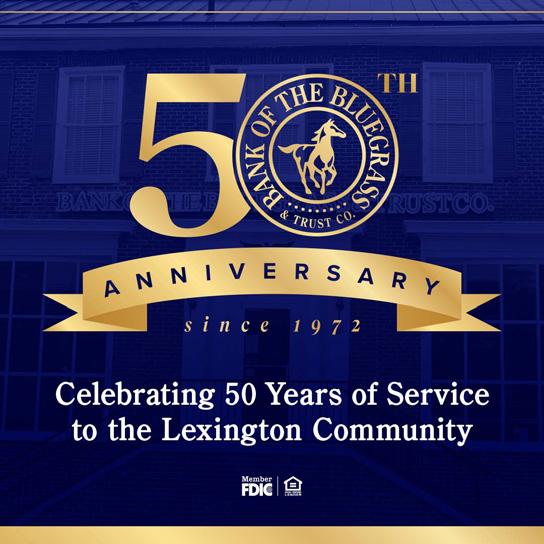
employees will share $200 worth of gifts or donations, for a total of $3,600 in Random Acts over nine months, to a recipient or recipients of their choosing. Each time an employee makes a gift or donation, they will also give out a card asking the local business, client, non-profit or individual to “pay it forward” by blessing a neighbor with a gift, or other random act of kindness.


“It would be easy to commemorate this milestone with a party and a pat on the back for ourselves,” said Tom Greinke, Bank President. “But this celebration is more than that. It’s the recognition of a community that has accepted us and carried us through good times and bad, and this is another way we could thank them for that.”
The bank has a year-round random acts of kindness program; the

Let us help you uncover hidden opportunities at EmbraceVolatility.com. © 2022 Crowe LLP. Visit www.crowe.com/disclosure for more information about Crowe LLP, its subsidiaries, and Crowe Global. Audit2399-002AI Embr ace Volatili ty
COMPLIANCE CORNER
by Timothy A. Schenk KBA Deputy General Counsel/Director of Education tschenk@kybanks.com

What do I do? Account Dormant, Abandoned, or Both
One of the most common questions we receive at the KBA is, “What do I do with this dormant account?” or “What do I do with this abandoned account?” While the terms are used interchangeably as if they are the same thing, the reality is that they are two distinct situations that require understanding of subtle differences to meet not only internal bank policy, but statutory requirements on how you treat your customers’ property.
Dormancy is determined by your bank’s policy. Policies related to dormancy vary, but generally speaking, most banks consider types of property, particularly deposit accounts, dormant after there has been no activity for one (1) year. Many banks have dormancy fees, schedules and other internal rules on how to handle dormant accounts. Nonetheless, the key point to understand with dormancy is that these are subject to your bank’s own rules. The most important factor in understanding dormancy is that you must apply your policies, whatever they may be, across all demographics and customers equally to avoid any potential UDAAP, fair lending, or other violations. You also must make sure that all portions of your dormancy policy are properly disclosed to avoid any confusion or potential claims.
Abandonment is governed by state law located in the Kentucky Revised Statutes, particularly section 391A.040 et seq. Most of the abandonment schedules applicable to banks are located in KRS 393A.040. KRS 393A.040(5), which states that most deposit accounts are presumed abandoned after three (3) years. Other types of property commonly subject to abandonment include safe-deposit boxes, which are generally presumed abandoned five (5) years after the expiration of the lease or rental under KRS 393A.080. Custodial accounts of a minor are generally presumed abandoned three (3) years after second notification to the custodian under KRS 393A.070. Some tax-deferred retirement accounts can be presumed abandoned in as little as three (3) years under KRS 393A.050. In short, there is a schedule for abandonment under KRS 393A for nearly every type of property.
It is important to remember that even with the timelines listed above, there are certain prerequisites for different types of property before they can be presumed abandoned. For example, when dealing with tax-deferred retirement accounts, KRS 393A.050 requires the holder, which would be the bank in most instances, to send the “apparent owner” two notices via first-class mail. The requirements for the notice are generally set forth in KRS 393A.280. There are even rules for establishing the address of the apparent owner and burdens of proof. In short, abandonment statutes contain many nuances regarding the type of property that make it important to thoroughly understand different prerequisites before treating the property as abandoned.
If you have abandoned property, it is also important to remember that you have to report it! You may contract with a third party to report the
abandonment, but ultimately you are responsible “for the complete, accurate and timely reporting of property presumed abandoned.” The contents of the report are set forth in KRS 393A.230 and the report itself must be filed by November 1st of each year and “cover the twelve (12) months preceding July 1 of that year.” If you are feeling overwhelmed that you may not complete your report by November 1st, you may request an extension.
There is also a record keeping requirement associated with abandonment. A holder required to file a report “shall retain records for ten (10) years after the later of the date the report was filed or the last date a timely report was due to be filed, unless a shorter period shall be provided by rule of the administrator. The holder may satisfy the requirement to retain records under this section through an agent. The records shall contain: (1) The information required to be included in the report; (2) The date, place, and nature of the circumstances that gave rise to the property right; (3) The amount or value of the property; (4) The last address of the apparent owner, if known to the holder; and (5) If the holder sells, issues, or provides to others for sale or issue in this state traveler’s checks, money orders, or similar instruments, other than third-party bank checks, on which the holder is directly liable, a record of the instruments while they remain outstanding indicating the state and date of issue.”
One of the most common questions regarding abandonment is fees. You can recover a fee as long as it is “conscionable considering all relevant factors.” There must be a valid contract between the holder and the apparent owner authorizing the imposition of the charge for the apparent owner’s failure to claim the property within a specified time. In addition, the holder regularly imposes the charge and regularly does not reverse or otherwise cancel the charge. You can even recover costs for removal of a safe deposit box.
Nonetheless, the key to successful compliance with dormancy and abandonment is understanding the rules and implementing them as part of your bank’s policy. Distinguishing between your internal rules, dormancy, and Kentucky law, abandonment, is a great first step!
You may be saying to yourself, “Are we doing this right?” This seems complicated! Do not panic! A review of your policies and procedures should provide some comfort that you are doing things correctly. More importantly, if you feel as if you are missing something, it is never too late to change! Administrators generally appreciate policy and practice changes that make your institution complaint with regulations. Finally, if you find yourself lost and need guidance, the KBA is always here with training and materials to help make sure your garnishment practices are compliant!
16 | KENTUCKY BANKER
Join the largest bank network in America
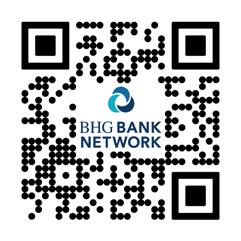
























Jordyn Sollars VP, Institutional Relationships 315.657.4431 jsollars@bhg-inc.com BHGBank.Network/KBAEV
Climate Change and Climate Risk Management for Banks
by Julia A. Gutierrez, Bankers Alliance
Climate change and risk management have become a hot button topic for financial institutions in recent years as a result of the rising concern by policymakers, international organizations, financial regulators, and so many others. There has been such a push in recent years for a more environmentally friendly world as we see changes in organizational resources and operations, investor expectations, environmental activists, and even the expectations of the current administration. With all the focus on environmental safety, considering the impacts and learning how to manage the risk is the inevitable for financial institutions.
What Is Climate Change?
When it comes to climate change, this is considered to be a change in global or regional climate patterns. More specifically, a change in global or regional climate patterns from the mid-20th century through today, which has been largely attributed to an increase in atmospheric carbon dioxide levels which are produced by fossil fuel usage. It can be a controversial topic among various group but whatever side of the fence you stand on when it comes to climate change, there are climate-related financial risks faced by banks and managing that risk can be critical.
What Type of Risk Should You Consider?
According to the varying regulatory agencies, climate change and the transition to a low carbon economy have been identified as factors which have contributed to emerging risks in which financial institutions and the overall financial system of the United States are faced with. The agencies indicate that banks will likely be impacted by physical risks and transition risks associated with climate change.
The harm to people and property which arises from acute, climate-related events (flooding, hurricanes, heatwaves, etc.) is considered physical risks. Stresses to financial institutions as a result of the shifts in policy or consumer or business sentiments, or changes in technology in order to limit the impact of climate change are considered transition risk. Basically, transition risk is the risk as a result of the transition to a more en-
vironmentally friendly process or way of conducting business and operations. Other risks that financial institutions should consider as it relates to climate change and the environment include credit risk, market risk, liquidity risk, operational risk, and reputational risk. Banks must consider the various areas of risk, especially as they consider the safety and soundness of their institution.
Principles for Managing Climate Related Risk
While there isn’t specific regulatory guidance for achieving compliance and managing the risk related to climate, at the current time, we are likely to see this type of guidance in the near future. Regulatory agencies have addressed the issues and have requested feedback for managing the risk and are looking at implanting regulatory requirements for large financial institutions. This would include banks with over $1 billion in assets. The OCC (Office of the Comptroller of Currency) along with other regulatory agencies have released guidance, requests for information, and a set of principles by which financial institutions should consider in managing climate related risks. The information released by the OCC includes a set of general principles as well as the specific areas of risk management.
The general principles touch on governance; policies, procedures, and limits; strategic planning; risk management; data, risk measurement, and reporting; and scenario analysis. The general principles provide guidance for developing an effective framework that is essential to the bank’s safe and sound operations. The principles outline expectations for board and senior management oversight, guidance for developing a written program, the areas of consideration for planning which should take into account the bank’s overall business strategy, risk appetite, and financial, capital, and operational plans.
It is also important that management is involved in the oversight of the development and implementation process for identifying, measuring, monitoring, and controlling climate-related financial risk exposure within the bank’s management framework. Sound climate risk management is dependent upon the availability of relevant, accurate, and timely data; therefore, management should incorporate climate related financial risk information into the bank’s internal reporting, monitoring, and
18 | KENTUCKY BANKER
continued on next page
escalation processes to facilitate timely and sound decision-making across the bank. An important approach for identifying, measuring, and managing climate-related risks is the development of climate-related scenario analysis.
In order to ensure this framework is effective and successful, financial institutions should consider a risk assessment process as part of their sound risk governance framework. This will ensure that the board and senior management are able to identify emerging risk in order to develop and implement the appropriate strategies to mitigate and manage the risks.

The guidance issued by the OCC suggests that financial institutions should consider incorporating climate-related financial risks when identifying and mitigating all types of risk. While the agencies will eventually elaborate on risk assessment principles in subsequent guidance, it is suggested that financial institutions consider credit risk, liquidity risk, other financial risk, operational risk, legal/compliance risk, and other nonfinancial risk.
Conclusion
While there isn’t currently a specific set of guidance that financial institutions must abide by when it comes to climate risk, compliance, and management, this is an area which all banks should begin considering from a safe and sound banking standpoint. It is looking like the future guidance related to climate risk will only apply or be required by large financial institutions, however, the guidance and risk considerations should be contemplated by institutions of all sizes. Risks can impact even smaller institutions, therefore, taking a proactive approach rather than a reactive response is always the best plan of action. It is important that financial institutions stay abreast of the hot button area of climate change and climate risk, from a compliance and risk management perspective, as the society in which we are living continues to set a higher standard for an environmentally friendly world.

19 | KENTUCKY BANKER
The community bank compliance partner. That’s Review Alliance. Explore how R/A can help - Talk with our team at info@bankersalliance.org or (833) 683-0701. Holding Company of Compliance Alliance and Review Alliance Which special projects does your team need to tackle to have all your 2023 submissions ready for exams? Scan the QR code for R/A’s capabilities. “Risks can impact even smaller institutions, therefore, taking a proactive approach rather than a reactive response is always the best plan of action.”

BigIronPROFILEAuctions
Hello, from BigIron Auctions. I am Shane Bundy, the District Manager for BigIron Auctions in Kentucky. I have met many of you at the conferences, but for those I have not met, please let me introduce you to BigIron Auctions.

Firstly, I would like to thank the Kentucky Bankers Association and its members for their warm welcome to the KBA. I have truly enjoyed being able to meet everyone. When I first spoke with Selina Parrish about becoming a member of the Kentucky Bankers Association, I wasn’t sure how our partnership might benefit each other, I quickly realized how great the KBA organization is and how BigIron Auctions can assist its members. Not only can BigIron Auctions help its members with repossessions, but we can also help sell their ag, construction, and transportation equipment.

BigIron Introduction
Since 1984, Mark & Ron Stock have been teaming up with rural America to provide the best auction experience. They started as a traditional onsite auction company working locally with one farmer auctions. Understanding the power of the internet, they created a digital platform for online auctions and created BigIron Auctions in 2009. They went from local one farmer auctions to multiple farmer auctions with many auction items. Today, it is not uncommon to have 200 sellers and a couple thousand items on each week’s auction. We can have multiple auctions happening every week: equipment, livestock, land and even a classic car auction going on during the week with bidders worldwide.
The BigIron Difference
1. Unreserved Auctions: all items will be sold to the highest bidder at auctions end, increasing bidder confidence knowing the equipment will sell.
2. Lien Free: BigIron works with sellers and creditors to make sure the item will go to the buyers. All equipment will transfer lien free and clear.
3. Full Service: BigIron Independent Sales Representatives goes to the equipment location, write descriptions, capture photos, videos, and upload the listing to our site. BigIron professionals manage the entire auction: marketing the equipment, ensuring clear title, collecting payments, and then handing over the check to the seller.
4. Quality Listings: EACH COMPREHENSIVE LISTING INCLUDES a description which accurately showcases the equipment, image gallery and video of equipment, seller contacts and sales reps listed for additional questions, resources – when available, specs, build sheets, and maintenance records are included.
5. Dedicated Marketing Plan: tailored to assets being sold and targeted to those most likely to buy.

6. Transparency: the sellers contact information is listed on every item, buyers are encouraged to call the seller and if possible, go see the equipment.
7. Consistent Experience: the sales team is local, very well trained, this results in best-in-class service and a uniform experience with BigIron.
8. Respected Values: Mark & Ron Stock have instilled in BigIron the midwestern work ethic and to treat every customer as if they are our only customer, transparency and honesty are at the forefront of doing business with BigIron Auctions.
BigIron Auctions is one of the fastest growing online auction companies in the nation, striving to give the best auction experience to our customers. BigIron is committed to core values that will provide you with a great auction experience and does all the heavy lifting needed to get your item to a successful auction. Contact

KENTUCKY BANKER / 21
Shane Bundy today to hear more about our core values and auction process. SHANE BUNDY 606-224-6035 District Sales Manager D21 – Midwest Region shane.bundy@bigiron.com bigiron.com ENDORSED VENDOR
Guide to Security Awareness for Customers
by Eric Chase Information Security Consultant, Client Services SBS CyberSecurity
Education and security awareness training are powerful tools when it comes to creating a strong information security program. It helps establish trust that your organization takes cybersecurity seriously and that you’re committed to doing what’s best for your employees and customers.
An organization with a strong security culture goes beyond internal employees and talks about cybersecurity threats with its customers as well. Educating customers about the dangers of cyber threats helps build a stronger relationship. Cyber-savvy customers also benefit your business. A more secure customer will reduce the risk of their information becoming compromised or used maliciously against your business.
Cover the Basics
Your customers can benefit from the same security awareness topics shared internally, including, but not limited to:
• Recognize and report phishing
• Type of attacks/what controls can mitigate the risk
• Physical security threats and best practices
• Password best practices/password management tools
• Enable multi-factor authentication whenever possible
• Updating software and patch management
• Remote access security
• Use of encryption
• Mobile device security
• Defending against malicious software
• Importance of anti-virus and firewalls
• Incident response plans
Tips to Share Your Knowledge
Most companies do not employ a staff of cybersecurity experts or only offer services to customers with a security background, so it is important to provide basic cybersecurity knowledge, best practices, and tips on a regular basis. A strong culture of cybersecurity at your organization has benefits beyond mitigating cyber risks; it builds confidence amongst your employees and customers that you have made it a priority.
Using multiple delivery channels to support training and education can help ensure your customers see it throughout the year.
Delivery channels can include:
• Place or link to relevant cybersecurity tips, news stories, alerts, and cyber policies on your business website.
• Include a monthly tip in your newsletter or social media accounts to keep cybersecurity top-of-mind for your customers.
• Encourage your customers and employees to follow your organization or other cybersecurity organizations on social media for cyber tips and news.
22 | KENTUCKY BANKER
organization with a strong security culture goes beyond internal employees and talks about cybersecurity threats with
• Incorporate cybersecurity tips into your on-hold message when customers call your business.
• Include cybersecurity resources with physical statements or invoices.
• Provide cybersecurity resources, control suggestions, or self-audits at the time of account opening.
• Place posters, articles, or other educational materials in the entryway, break room, bathroom, or other meeting areas.
• Invite your business customers and employees to attend an educational webinar, such as the free monthly Hacker Hour webinar hosted by SBS.
Host an Event
One of the most popular and effective training methods is to invite your employees and customers to a virtual or in-person event. Getting out in front of your customers and talking about the importance of cybersecurity is a win/win:
1. You are helping to create cyber strong customers that are more resistant to attacks, benefiting both you and your customer.
2. You show your customers they are more than just a number. You’re strengthening relationships and demonstrating care about their well-being.
3. You have an opportunity to show off new products/ services or new features, as well as potentially increase the adoption of existing products or services.
For business customers: Plan a lunch and learn event focusing on the latest cybersecurity trends and tips for securing their business.
For the community: Host a cybersecurity awareness day for community members to shred sensitive documents, listen to short presentations, and play cyber-themed games or trivia.
For employees: Have an external presenter conduct training to help increase engagement. Many speakers will also make it fun by incorporating games or prizes for participants.
For your board: Have an expert discuss the trends they are witnessing and the risks associated to generate increased buy-in.
Here are some additional considerations to keep in mind:
• Invite the community.
• Host several sessions to cover the most people possible. Consider recording the session for those unable to attend and/or to use for content later.
• Choose a platform (if virtual) that is easily accessible by your customers, user-friendly, and secure.
• Pair up with your chamber of commerce, a civic organization, or an academic institution.
• If you’re not confident talking about cybersecurity, bring in a cybersecurity expert to speak on your behalf.
Talking about cybersecurity also offers a chance for your customers to see how your organization is protecting their information. In today’s market, where cybersecurity is becoming a deciding factor for consumers with many options, being open and transparent about cybersecurity can instill customer confidence and draw in new customers.
sbscyber.com
SBS helps business leaders identify and understand cybersecurity risks to make more informed and proactive business decisions.

23 | KENTUCKY BANKER
“An
its customers as well.”



24 | KENTUCKY BANKER 2022 SPRING CONFERENCE APRIL 23-25 kbaspringconference.com frenchlick.com
Stock Yards Bank Chairman and CEO Among “Most Admired”
Stock Yards Bank’s Chairman and CEO Ja Hillebrand was recently recognized as one of this 2022’s Most Admired CEOs by Louisville Business First. Hillebrand, who is also the current KBA Past Chairman, has always had a passion for the communities we serve, the honor cites. Here is Ja’s perspective on community banks.
We’re also a part of some of the most trying times. We as community bankers shined when we stepped up to facilitate millions of dollars in PPP loans during the pandemic. We were quick, we were effective, and we were efficient to get money in the hands of people who needed it. That deserves a lot of credit and recognition.
It’s impossible to measure the value of what bankers do. I see how banks grow deep roots in their communities and create ripple effects through charitable donations, involvement, and action. We can also impact the rules and regulations that dictate how we do business through outreach and relationship building with legislators and other decision makers.
It’s clear that while we as bankers compete, we have the same goals in the end. We want to support our communities. We want to help people and businesses meet their goals. We want to be advocates for positive change. And we want to be better community bankers.
What Being a Community Banker Means to Me
I’ve known the importance of relationship-building and giving back to my community from a young age. My family owned a local business, Hillebrand Electric Company, where I would have worked had I had any talent as an electrician (I guess you could say I wasn’t wired that way). Still, I saw firsthand how small businesses make real impacts on the people they serve and dedicate themselves to the betterment of their communities.
Being one of eight kids also gave me a strong sense of paying things forward and doing the right thing. So instead of stringing wires or digging trenches, I wanted to learn how to run a business like my father with the hopes of giving back to the people and community that helped raise me. I first started in banking more than 30 years ago. While studying at Bellarmine University, I took a part-time job as a teller at a local community bank to help pay my tuition. That job led to a management training program opportunity that changed the course of my life.
Had that local bank not invested in me, I wouldn’t be where I am today. Being a community banker has given me a chance to be involved to help others on their path and support programs that make our cities better. It also allows me to serve on the boards of nonprofits, sponsor charitable events and be involved in projects that drive our economy forward and “practice what I preach.”
Being a community banker hinges on the relationships we make – with our colleagues, with our customers and with each other. Being a banker allows me to practice the values instilled in me from my family and the family business. Banking is a way to make a real impact on individuals and communities. Banks are a vital part of some of the most exciting times in the lives of our community members, like buying a house, starting a business, saving for college or planning retirement.
Stock Yards Bank Named One of the
“Best Banks to Work For in 2022”
Stock Yards Bank & Trust has once again been named one of the Best Banks to Work For by American Banker and Best Companies Group. The community bank, which has 73 branch offices in Louisville, central, eastern and northern Kentucky, as well as the Indianapolis, Indiana and Cincinnati, Ohio metropolitan markets, was one of only 90 banks featured on the 2022 list.
Fidler Named Stock Yards Bank Chief Investment Officer

“John has made significant contributions in nearly seven years of dedicated service to Commonwealth Bank and Stock Yards Bank,” said Stock Yards Bank Chairman and CEO James “Ja” Hillebrand. “In this new position, I have no doubt his vision and longstanding experience will prove to be invaluable as we help chart the path to brighter futures for our clients, customers and the communities we serve.”
“I am honored to serve in this chief investment officer role to help develop strong investment strategies for our clients and customers,” said Fidler. “I look forward to leading the team to maintain and expand our best-in-class processes and wealth management platforms that will help drive Stock Yards Bank & Trust to new heights.”

25 | KENTUCKY BANKER
15 Rewarding New Year’s Resolutions
For a Healthy Happy Life!
1. Build a better budget.
If there’s one New Year’s resolution that will help you the most in the long run, it’s making a vow to save more money. Before you head back to the office in January, outline a rough budget that works for you — and make a plan for how you’ll stick to it. Apps like Mint and You Need a Budget (YNAB) can help you do this as painlessly as possible. And supercharge your shopping habits by rethinking when and how you buy things for your home and family; often, there are savings you’re leaving on the table.
2.
Practice mindfulness.
Anxiety can nag at anyone during any season, in all parts of life — and it can be easy to let the idea of the future or past experiences inform your reality of the present. Practicing mindfulness means doing everything you can to be grateful for what you have in the moment, where you are in life, and who you are right now, shared Sabrina Romanoff, Psy.D., a clinical psychologist in New York City and Yeshiva University professor. Romanoff and other leading psychological experts say committing to mindfulness can help you become a better person in less than a year’s time.
3. Cook something new each week.
Everyone wants to eat healthier in the new year, but you should also try to eat more diverse foods. After all, variety is the spice of life. This year, choose an easy dinner recipe you’ve never tried before at least once a week. Some ways to schedule this is by ethnicity. Italian one week, Chinese the next, etc. You can also try to fix a different Crock Pot dish every week. Fix chicken a different way every week. There are a lot of ways to get variety!
4. Read more books.
January is the perfect time of year to snuggle up with a new book. To keep yourself accountable all year long, why not link up with friends and peers to connect over the best pages you’ve read? Start a Book Club with your family, neighbors or coworkers.
5. Create a cleaning schedule you’ll stick to.
Keeping your home tidy without doing what feels like a deep clean every week can feel like a big ask. It’s true that you may be under cleaning some tricky spots, but it’s also true that you may be overdoing it elsewhere.
6. Drink Less alcohol.
You already know you don’t need to drink to have fun — so why not make this year the one you cut back and join the sober curious movement? Doing so can help to improve your mood, sleep, skin and your immune system. Plus, it’ll also help you save money in the long run.
7.
Commit to a healthier sleep routine.
So many issues can be traced back to a poor night’s sleep. And yet, there is so much more that we can aim to improve beyond a reasonable bedtime. Creating a plan to improve your sleep hygiene — the habits you maintain to get good sleep every night — may look different for everyone, as it depends on when you need to be active and working throughout the day. Your brain actually relies on cues to regulate your internal circadian rhythm, and the choices you make throughout the day can interfere with these. Start taking charge of your sleep.
8. Prioritize annual health screenings.
Open your calendar app (or planner!) and make your appointments for the year in one sitting — not only will you get the anxiety-inducing nuisance over with, but exams will be less likely to get squeezed out as life gets bonkers. Start with your primary care provider, and ask which screenings (e.g., mammogram, colonoscopy) you’re due for. Slot those in, then move on to the dentist’s office and head over to your ophthalmologist, too.

26 | KENTUCKY BANKER
15 Rewarding New Year’s Resolutions
9. Exercise your Brain.
Scientists are always learning more about how humans work to stave off cognitive decline — and while data may be divided, if one thing is sure, games can indeed play a role here. Researchers at Duke University studied participants’ brain activity while they completed simple math problems and found that solving them feels like a reward, helping to curb negative feelings.
10. Plan a vacation.
People who vacation at least twice a year have a lower heart attack risk than those who do so rarely. And researchers have found that even thinking about an upcoming trip can boost happiness for weeks.
11. Drink up.
You know you need to hydrate — but it’s especially important when you get only six hours of sleep (or less!). You’re more likely to be dehydrated the day after a disrupted night of sleep, because a hormone that regulates your body’s water conservation is released during later stages of sleep. So down some extra water on those days if you can — and remember that too much water can be tricky for your gut, too.
12. Volunteer regularly.
Research shows that pitching in regularly can lead to less stress and lower blood pressure. Try to schedule an outreach mission of your own on a day of service; many recognize Martin Luther King Day as a prime opportunity, or even Veteran’s Day in November. So use this day to jumpstart a longer-term personal commitment — and consider working on this goal with loved ones all year round.
13. Learn or hone a new skill.
Leaving your home to learn something new from an expert located across the world isn’t necessary anymore. Turn to global leaders and celebrity leaders to boost your memory skills and more. MasterClass has recently announced plans to launch new courses from inspiring leaders like Indra Nooyi to musicians including John Legend in 2023. There’s a keen focus on intentional courses like successful wedding planning 101 led by Mindy Weiss and even topics like intentional giving led by Melinda Gates.
14. Start walking more.
Even if you can’t keep track of a new fitness routine, keeping yourself moving on a simple walk around the neighborhood is a must. The U.S. Department of Health and Human Services maintains that adults should spend as much time moving each day as possible — and some physical activity (even just walking!) is better than none.

15. Ease stress with kindness.
Kindness toward yourself, that is! Recent research shows that practicing self-compassion slowed people’s heart rate and sweating, two symptoms our bodies produce when under chronic stress. So take some time each day to focus on something you love about yourself.
For info on KBA Benefit Solutions, contact: Lisa Mattingly, Director of Sales and Service 502-736-2683 / lmattingly@kybanks.com

27 | KENTUCKY BANKER































































































